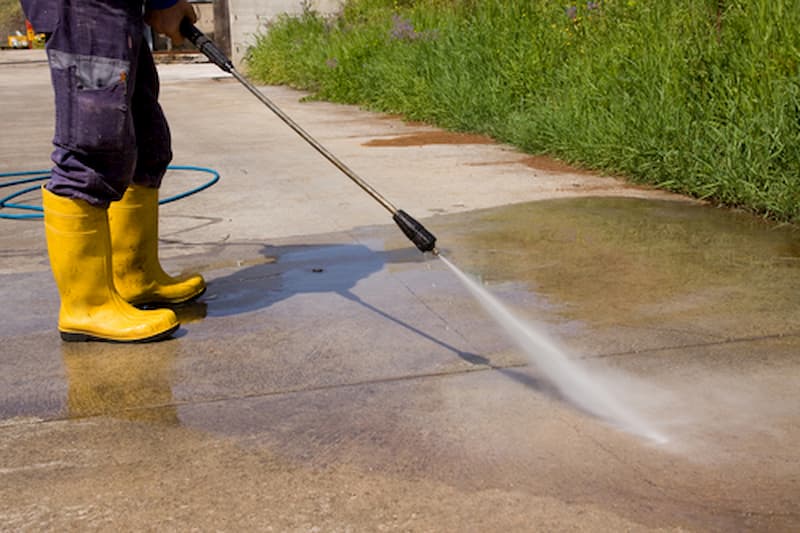As winter fades away and spring arrives, it’s the perfect time to inspect and maintain your concrete surfaces. The cold months can take a toll on driveways, patios, sidewalks, and other concrete areas, leading to cracks, stains, and structural wear. Proper spring cleaning and maintenance can extend the lifespan of your concrete and enhance your property’s curb appeal. This ultimate guide will help you clean, repair, and protect your concrete surfaces effectively.
Concrete maintenance in Illinois is essential, especially after the harsh winter months. Start your spring cleaning by inspecting driveways, patios, and sidewalks for cracks or damage caused by freeze-thaw cycles. Clean the surfaces with a pressure washer or a mild detergent solution to remove dirt, salt, and grime buildup. Address minor cracks with a concrete patching compound to prevent further deterioration. Applying a high-quality sealer will protect your concrete from moisture, stains, and future weather damage. Regular Concrete Maintenance Illinois not only enhances curb appeal but also helps prevent costly repairs, keeping your outdoor spaces in top condition year-round.
Why Spring Cleaning Is Essential for Concrete Maintenance
Winter weather, particularly in regions with freezing temperatures, can cause significant damage to concrete. The freeze-thaw cycle leads to cracks, and de-icing salts can accelerate deterioration. Additionally, accumulated dirt, mold, and mildew can make concrete surfaces unsightly and hazardous. A thorough spring cleaning removes debris, prevents further damage, and restores the integrity of your concrete.
Step-by-Step Guide to Spring Concrete Maintenance
1. Inspect Your Concrete Surfaces
Before cleaning, inspect all concrete areas around your home. Look for:
- Cracks and surface damage
- Stains from oil, grease, or de-icing chemicals
- Uneven or sinking sections
- Signs of mold or mildew
Taking note of these issues will help you address them effectively during the cleaning and maintenance process.
2. Gather the Right Cleaning Supplies
To properly clean your concrete surfaces, you’ll need:
- A stiff-bristled brush or broom
- A pressure washer (optional but highly effective)
- A garden hose with a spray nozzle
- A mild detergent or concrete cleaner
- White vinegar or baking soda for natural cleaning solutions
- Protective gloves and eyewear
3. Remove Debris and Surface Dirt
Start by sweeping away leaves, dirt, and debris. A leaf blower can make this task easier for larger areas. Removing surface dirt ensures a more effective deep cleaning.
4. Deep Clean with a Concrete Cleaner
For light cleaning, mix a mild detergent with warm water and scrub the surface using a brush. If you’re dealing with stubborn stains, consider using a specialized concrete cleaner. Follow these steps:
- Wet the surface with water.
- Apply the cleaning solution and let it sit for 10-15 minutes.
- Scrub the area with a stiff-bristled brush.
- Rinse thoroughly with a hose or pressure washer.
For a natural cleaning alternative, mix equal parts of white vinegar and water or use baking soda and water paste on tough stains.
5. Remove Oil and Grease Stains
Oil and grease stains are common on driveways and garage floors. To remove them:
- Sprinkle cat litter or baking soda over the stain and let it absorb the oil for several hours.
- Sweep up the litter and scrub the area with dish soap and warm water.
- Rinse with water and repeat if necessary.
6. Eliminate Mold and Mildew
Mold and mildew thrive in damp, shaded areas. To remove them:
- Mix one part bleach with three parts water.
- Apply the solution to affected areas and let it sit for 10-15 minutes.
- Scrub and rinse thoroughly with water.
7. Repair Cracks and Damage
Small cracks can quickly turn into larger structural issues if left untreated. To repair cracks:
- Clean the crack thoroughly with a wire brush.
- Use a concrete patching compound or crack filler.
- Smooth the surface and let it dry according to the manufacturer’s instructions.
For larger cracks or sinking sections, consider hiring a professional for concrete leveling or resurfacing.
8. Seal Your Concrete Surfaces
Sealing your concrete is one of the best ways to protect it from future damage. A high-quality concrete sealer:
- Prevents water penetration
- Reduces wear and tear from foot traffic and vehicles
- Protects against stains and chemical damage
To apply a sealer:
- Ensure the surface is clean and dry.
- Use a roller or sprayer to apply an even coat.
- Allow the sealer to dry completely before using the area.
9. Maintain Your Concrete Regularly
Once your concrete is cleaned and repaired, regular maintenance will keep it in top condition. Here are some tips:
- Sweep and wash concrete surfaces monthly.
- Reseal every 2-3 years for maximum protection.
- Avoid using harsh de-icing salts in winter.
- Address stains and cracks promptly.
Special Considerations for Different Concrete Areas
Driveways
- Regularly remove oil stains and debris.
- Avoid parking heavy vehicles on weak spots.
- Consider resurfacing if the driveway has extensive wear.
Sidewalks and Walkways
- Keep walkways free of moss and mold to prevent slipping.
- Repair cracks to avoid tripping hazards.
- Relevel uneven sections as needed.
Patios and Pool Decks
- Use a mild cleaner to avoid damage to surrounding landscaping.
- Ensure proper drainage to prevent standing water.
- Reapply a non-slip sealer for added safety.
Garage Floors
- Clean up spills immediately to prevent staining.
- Use a durable epoxy coating for added protection.
- Keep the floor dry to prevent moisture damage.
Conclusion
Spring is the perfect time to give your concrete surfaces the care they need. By following this comprehensive guide, you can remove winter grime, repair damage, and protect your concrete for years to come. Regular maintenance not only enhances your property’s appearance but also helps prevent costly repairs. Invest a little time this spring to ensure your concrete remains strong, durable, and visually appealing throughout the year.

